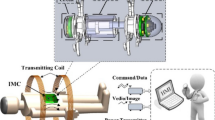Abstract
An optimizing method for designing the wireless power receiving coil (RC) is proposed in this paper to address issues such as insufficient and fluctuating power supply in the near-infrared capsule robot. An electromagnetic and circuit analysis is conducted to establish the magnetic induction intensity and equivalent circuit models for the wireless power transmission system. Combining these models involves using the number of layers in each dimension as the optimization variable. Constraints are imposed based on the normalized standard deviation of the receiving-end load power and spatial dimensions. At the same time, the optimization objective aims to maximize the average power of the receiving-end load. This process leads to formulating an optimization model for the RC. Finally, three-dimensional RCs with three different sets of parameters are wound, and the receiving-end load power of these coils is experimentally tested under various drive currents. The experimental values of the receiving-end load power exhibit a consistent trend with theoretical values, with experimental values consistently lower than theoretical values. The optimized coil parameters are determined by conducting comparative experiments, with a theoretical value of 4.6% for the normalized standard deviation of the receiving-end load power and an average experimental value of 9.6%. The study addressed the power supply issue of near-infrared capsule robots, which is important for early diagnosing and treating gastrointestinal diseases.

摘要
针对近红外胶囊机器人的能量供给不足、波动过大等问题,提出了一种无线能量接收线圈设计优化方法。首先通过电磁与电路分析,建立了无线能量传输系统的磁感应强度模型与等效电路模型。结合上述模型,以各维度绕组层数为优化变量,以接收端负载功率归一化标准差和空间尺寸为约束条件,以接收端负载功率平均值最大化为优化目标,建立了接收线圈的优化模型。最后,绕制了三种不同参数的三维接收线圈,通过实验测试了不同驱动电流下的接收端负载功率,对优化结果进行了验证。实验结果显示:接收端负载功率实验值与理论值变化趋势一致,实验值均小于理论值;接收端负载功率归一化标准差理论值为4.6%,平均实验值为9.6%。该研究解决了近红外胶囊机器人的供电问题,对胃肠道疾病的早期诊断和治疗具有重要意义。
Similar content being viewed by others
References
National Health Commission of the People’s Republic of China. 2022 China health yearbook [M]. Beijing: Peking Union Medical College Press, 2022 (in Chinese).
SUNG H, FERLAY J, SIEGEL R L, et al. Global cancer statistics 2020: GLOBOCAN estimates of incidence and mortality worldwide for 36 cancers in 185 countries [J]. CA: A Cancer Journal for Clinicians, 2021, 71(3): 209–249.
WANG W, YAN G Z, HAN D, et al. Design and testing of a novel gastrointestinal microrobot [J]. Biomedical Microdevices, 2020, 22(4): 82.
WANG W, YAN G Z, WANG Z W, et al. A novel expanding mechanism of gastrointestinal microrobot: Design, analysis and optimization [J]. Micromachines, 2019, 10(11): 724.
IDDAN G, MERON G, GLUKHOVSKY A, et al. Wireless capsule endoscopy [J]. Nature, 2000, 405(6785): 417–417.
PU P X, YAN G Z, WANG Z W, et al. Design and experiment of expanding mechanism and power receiving coil for micro intestinal robot [J]. Journal of Shanghai Jiao Tong University, 2019, 53(10): 1143–1150 (in Chinese).
METZGER Y. Comparison of a new PillCam™ SB2 video capsule versus the standard PillCam™ SB for detection of small bowel disease [J]. Reports in Medical Imaging, 2009, 2: 7–11.
ELIAKIM R, YASSIN K, NIV Y, et al. Prospective multicenter performance evaluation of the second-generation colon capsule compared with colonoscopy [J]. Endoscopy, 2009, 41(12): 1026–1031.
GHEORGHE C, IACOB R, BANCILA I. Olympus capsule endoscopy for small bowel examination [J]. Journal of Gastrointestinal and Liver Diseases, 2007, 16(3): 309–313.
ZHOU H, ALICI G. A novel magnetic anchoring system for wireless capsule endoscopes operating within the gastrointestinal tract [J]. IEEE/ASME Transactions on Mechatronics, 2019, 24(3): 1106–1116.
ZHANG Y S, CHEN J, ZHANG Y, et al. Self-centering characteristics of a petal-shaped capsule robot [J]. Science China Technological Sciences, 2019, 62(4): 619–627.
DING Z, SHI H Y, ZHANG H, et al. Gastroenterologist-level identification of small-bowel diseases and normal variants by capsule endoscopy using a deep-learning model [J]. Gastroenterology, 2019, 157(4): 1044–1054.e5.
CHEN X, GAO F, ZHANG J. Screening for gastric and small intestinal mucosal injury with magnetically controlled capsule endoscopy in asymptomatic patients taking enteric-coated aspirin [J]. Gastroenterology Research and Practice, 2018, 2018: 2524698.
LU F, SANG R Y, TANG Y, et al. Fabrication of a phototheranostic nanoplatform for single laser-triggered NIR-II fluorescence imaging-guided photothermal/chemo/antiangiogenic combination therapy [J]. Acta Biomaterialia, 2022, 151: 528–536.
SHI H, SUN Y D, YAN R Q, et al. Magneticsemiconductor Gd-doping CuS nanoparticles as activatable nanoprobes for bimodal imaging and targeted photothermal therapy of gastric tumors [J]. Nano Letters, 2019, 19(2): 937–947.
GAO J Y, ZHOU J S, YUAN C S, et al. Stable wireless power transmission for a capsule robot with randomly changing attitude [J]. IEEE Transactions on Power Electronics, 2023, 38(2): 2782–2796.
ZHUANG H Y, YAN G Z, FEI Q, et al. Characteristics of a hybrid three-dimensional transmitting coil for wireless power transmission of intestinal robot [J]. Journal of Shanghai Jiao Tong University, 2023, 57(5): 545–551 (in Chinese).
ZHUANG H Y, WANG W, YAN G Z. Omnidirectional wireless power transfer system using modified saddle-shaped coil pair for implantable capsule robots [J]. IEEE Transactions on Power Electronics, 2023, 38(9): 11664–11672.
CHEN F J, JIANG P P, YAN G Z, et al. Design of multi-coil wireless power transfer system for gastrointestinal capsule robot [J]. Journal of Shanghai Jiao Tong University (Science), 2021, 26(1): 76–83.
GAO J Y, YAN G Z, WANG Z W, et al. Design and testing of a motor-based capsule robot powered by wireless power transmission [J]. IEEE/ASME Transactions on Mechatronics, 2016, 21(2): 683–693.
GAO J Y, YAN G Z, WANG Z W, et al. A capsule robot powered by wireless power transmission: Design of its receiving coil [J]. Sensors and Actuators A: Physical, 2015, 234: 133–142.
GAO J Y, YAN G Z, SHI Y B, et al. Optimization of a powering coil onboard a dime-size inchworm-like robot for exploring the intestine [J]. Journal ofShanghai Jiao Tong University, 2020, 54(2): 152–159 (in Chinese).
Author information
Authors and Affiliations
Corresponding author
Ethics declarations
Conflict of Interest The authors declare that they have no conflict of interest.
Additional information
Foundation item: the Project of the Science and Technology Commission of Shanghai Municipality (No. 20142201300), the National Facility for Translational Medicine (Shanghai) Open Project Foundation (No. TMSK-2021-302), and the China Postdoctoral Science Foundation (No. 2023M732267)
Rights and permissions
About this article
Cite this article
Wang, W., Zhou, C., Jiang, J. et al. Optimization of Wireless Power Receiving Coil for Near-Infrared Capsule Robot. J. Shanghai Jiaotong Univ. (Sci.) (2024). https://doi.org/10.1007/s12204-024-2717-0
Received:
Accepted:
Published:
DOI: https://doi.org/10.1007/s12204-024-2717-0
Keywords
- near-infrared capsule robot
- fluorescence imaging
- wireless power transmission
- three-dimensional receiving coil
- design and optimization




